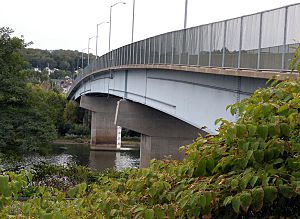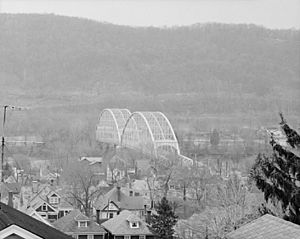Coraopolis Bridge facts for kids
The Coraopolis Bridge is a modern bridge that crosses a part of the Ohio River. It connects Neville Island to Coraopolis, Pennsylvania. This bridge opened in 1995. It replaced an older, very important bridge. That old bridge had a long and interesting history. It was once the Third Sixth Street Bridge in downtown Pittsburgh. It was built in 1892 and later moved to Coraopolis in 1927.
Quick facts for kids Coraopolis Bridge |
|
|---|---|

The current bridge
|
|
| Coordinates | 40°30′58″N 80°09′07″W / 40.51611°N 80.15194°W |
| Carries | |
| Crosses | Ohio River back channel at mile 9.6, CSX (formerly PLE railway ) |
| Locale | Coraopolis, Pennsylvania |
| Official name | Neville Island – Coraopolis Bridge |
| Maintained by | Allegheny County, Pennsylvania |
| Characteristics | |
| Design | Stringer girder bridge |
| Total length | 1108 ft |
| Longest span | 199 ft |
| Clearance below | 45 ft |
| History | |
| Opened | 1995 |
| Coraopolis Bridge (formerly the Pittsburgh Sixth Street Bridge) |
|
|---|---|

Overall view from Coraopolis side
|
|
| Carries | Grand Avenue (Neville Twp)/Pennsylvania Route 51 (Coraopolis) |
| Crosses | Ohio River back channel at mile 9.6, CSX (formerly PLE railway ) |
| Locale | Coraopolis, Pennsylvania |
| Official name | Neville Island – Coraopolis Bridge |
| Maintained by | Allegheny County, Pennsylvania |
| Characteristics | |
| Design | 2 Pratt/Bowstring/Pennsylvania through truss main spans, 2 pony truss side spans |
| Longest span | 2x 439 ft |
| Clearance below | 45.5 ft |
| History | |
| Opened | 1892 (original location) October 5, 1927 (this location) |
| Closed | 1986, replaced 1995 |
|
Coraopolis Bridge
|
|
| Lua error in Module:Location_map at line 420: attempt to index field 'wikibase' (a nil value). | |
| Location | Ohio River Back Channel at Ferree St. and Grand Ave., Coraopolis, Pennsylvania |
| Built | 1892 |
| Architect | Theodore Cooper, Baird Bros. |
| Architectural style | Bowstring Truss |
| MPS | Allegheny County Owned River Bridges TR |
| NRHP reference No. | 86000021 |
| Added to NRHP | January 7, 1986 |
Contents
Pittsburgh's Sixth Street Bridges: A History
The Coraopolis Bridge has a unique past. Its main parts were once the Third Sixth Street Bridge in Pittsburgh. This bridge connected Pittsburgh with a nearby city called Allegheny City. Connecting these areas with bridges was very important for Pittsburgh's growth. Allegheny City later became part of Pittsburgh in 1907.
The First Sixth Street Bridge (1819)
The very first bridge at Sixth Street was made of wood. It was a covered bridge, meaning it had a roof. This bridge was built in 1819 and was over 1,000 feet long. It was likely designed by a person named Mr. Lothrop.
The Second Sixth Street Bridge (1860)
In 1860, a new bridge replaced the old wooden one. This was a wire-suspension bridge. It was designed by the famous engineer John A. Roebling. He also designed the Brooklyn Bridge.
Even though it was made of iron, parts of this bridge caught fire in 1881. The fire damaged its wooden floor. People also worried about its strength. By 1891, plans began to replace it. The new bridge needed to handle more traffic, especially electric streetcars.
The Third Sixth Street Bridge (1892)
The third Sixth Street Bridge was designed by a well-known engineer, Theodore Cooper. He designed everything, even the handrails and lamps. This bridge was built in 1892.
It cost $560,000 to build. It was a toll bridge, meaning people paid to cross it. In 1893, men paid two cents, but women crossed for free! In 1911, the county bought this bridge and nine others. They then made all ten bridges free to use.
The main parts of the bridge were made by the Union Bridge Company. The Baird Brothers, John and William, built the bridge. They were famous bridge builders. William Baird worked on many big bridges, including some over the Missouri and Ohio Rivers. John Baird helped build the Eads Bridge in St. Louis.
Over time, this bridge also became too small for the growing city. The War Department decided that many bridges over the Allegheny River needed to be replaced. They were too low and narrow for river traffic. The Sixth Street Bridge was one of three bridges chosen for replacement. The other two were destroyed. But the Cooper bridge was special. It was moved and reused!
Moving a Bridge: The Sixth Street Bridge's Big Journey
The 1892 Sixth Street Bridge got a second chance. In 1927, instead of being torn down, it was moved. It traveled 12 miles downriver to a new home. This saved a lot of money for Allegheny County.
Why Move a Bridge?
Moving the bridge saved the county $350,000. This was much cheaper than building a brand new bridge in Coraopolis. The Foundation Company won the contract to move the bridge. They agreed to move it for $316,200. They also took on the risk if the bridge sank or was damaged.
Workers carefully removed the roadway. They left parts open for people to walk across until the very end.
How They Moved It
The main parts of the bridge, called trusses, were very heavy. Each one weighed 1,600 tons. They were also very tall, about 80 feet high. This was too tall to fit under two other bridges along the river.
The company could not take the trusses apart. They had to move the entire 450-foot-long sections. They used a special method to lower the bridge. They attached frames to the piers and used strong straps. Jacks slowly lowered the bridge 15 inches at a time. This careful process lowered the bridge by 16 feet in total.
The River Trip
Workers built a huge floating platform using barges. This platform was 400 feet long and 52 feet wide. It carried the bridge sections. They had to adjust the bridge's height to fit under the Manchester Bridge and another railroad bridge.
Tugboat captains carefully steered the bridge. They went through the Ohio River lock. Then they went up the back channel towards Coraopolis. New piers and supports were already built there.
Putting It Back Together
Once at its new location, the bridge was raised again. They used the same jacks and steel frames. The whole process of moving and reassembling the bridge took only 30 days.
The Farris Engineering Company did much of the work at the new site. They built parts of the supports. They also repaired and painted the bridge. They paved the bridge deck and the roads leading to it. The approach spans were made by the American Bridge Company.
The End of an Era
After almost 50 more years of service, the old Coraopolis Bridge was getting old. By the 1980s, it was in bad shape. It could not handle the heavy traffic anymore. It even had weight limits and closed during cold weather. For a while, it could only carry vehicles weighing three tons. It was only open when the temperature was above 30 degrees Fahrenheit.
Because of its condition, the county decided to replace it. The old bridge was finally closed, taken down, and replaced. This ended a truly unique story in American bridge history.
The Current Coraopolis Bridge
The bridge you see today at this location was built in 1994 and finished in 1995. It is a steel deck girder bridge. It crosses the back channel of the Ohio River. The main part of the bridge is about 199 feet long. The bridge deck is about 45 feet above the water.
Images for kids








